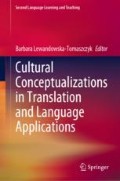Abstract
The development of writing was a milestone achievement in the history of humanity separating it from prehistory. However, some languages (like Polish Sign Language) still do not possess a written variant. Deaf Poles “talk” in Polish Sign Language but write in Polish. This article is an analysis of the effects Polish Sign Language has on the way Deaf Poles write in Polish based on a corpus of comments from a website dedicated to the Deaf. The article compares its results with those of Aleksandra Święcka who carried out a similar study in 2017. The analysis of the results sheds a different light on a claim that Deaf Poles write using “broken Polish.” The writing of the Polish Deaf might be neither written Polish nor written Polish Sign Language but something in the likes of a pidgin (Tomaszewski and Rosik in Człowiek wobec ograniczeń. Niepełnosprawność – Komunikacja – Terapia. Fundacja ORATOR, Lublin, pp. 133–165, 2002) or an interlanguage (Żurek in 40 lat wrocławskiej glottodydaktyki polonistycznej. Teoria i praktyka. Oficyna Wydawnicza ATUT, Wrocław, pp. 291–301, 2014).
Access this chapter
Tax calculation will be finalised at checkout
Purchases are for personal use only
Notes
- 1.
Prof. Jadwiga Linde-Usiekniewicz suggests that in this case we are not dealing with a lack of agreement but rather with an incorrect assignment of gender. If wiadomość is assigned a neuter, instead of the correct feminine, gender, then potrzebne [singular, neuter, nominative] is agreed correctly with it. According to this interpretation, a different deviation from standard Polish is present.
References
Baker, A., van den Bogaerde, B., Pfau, R., & Schermer, T. (2016). The Linguistics of Sign Languages. An introduction. Amsterdam: John Benjamins Publishing Company.
Czajkowska-Kisil, M. (2014). Głusi, ich język i kultura – zarys problematyki. In Lingwistyka przestrzeni i ruchu. Komunikacja migowa a metody korpusowe (pp. 17–36). Warszawa: Wydział Polonistyki Uniwersytetu Warszawskiego.
Czajkowska-Kisil, M., Kuder, A., & Linde-Usiekniewicz, J. (2014). Przestrzeń i ruch jako elementy strategii narracyjnych w opowiadaniu historyjek obrazkowych w polskim języku migowym (PJM). In Lingwistyka przestrzeni i ruchu. Komunikacja migowa a metody korpusowe (pp. 179–201). Warszawa: Wydział Polonistyki Uniwersytetu Warszawskiego.
Fabisiak, S., & Rutkowski, P. (2010). Polish Sign Language Verbs. In Proceedings of Verb 2010, Interdisciplinary Workshop on Verbs: The Identification and Representation of Verb Features (pp. 32–37). Pisa: Scuola Normale Superiore, Laboratorio di Linguistica, Università di Pisa, Dipartimento di Linguistica.
Farris, M. (1994). Sign language research and Polish Sign Language. Lingua Posnaniensis, 36, 13–36.
Grzegorczykowa, R., Laskowski, R., & Wróbel, H. (1999). Gramatyka współczesnego języka polskiego. Morfologia. Warszawa: Wydawnictwo Naukowe PWN.
Grzesiak, I. (2006). Kilka uwag o notacji signwriting, czyli tzw. piśmie migowym. Poradnik Językowy, 1, 57–67.
Łacheta, J., Czajkowska-Kisil, M., Linde-Usiekniewicz, J., & Rutkowski, P. (Eds.). (2016). Korpusowy słownik polskiego języka migowego, Warszawa (Online). http://www.slownikpjm.uw.edu.pl. Accessed on June 20, 2019.
Świdziński, M. (2000). Głusi uczniowie jako uczestnicy badań nad PJM. Audiofonologia, XVII, 67–78.
Świdziński, M., & Rutkowski, P. (2014). Ikoniczność nieleksykalna: reprezentacja referencjalna jako składnik tekstu w językach wizualno-przestrzennych. In Lingwistyka przestrzeni i ruchu. Komunikacja migowa a metody korpusowe (pp. 145–154). Warszawa: Wydział Polonistyki Uniwersytetu Warszawskiego.
Święcka, A. (2017). Polski język migowy a wypowiedzi pisemne ‘milczących cudzoziemców’. In P. Garncarek (Ed.), Kwartalnik Polonicum (pp. 38–43). Warszawa: Centrum Języka Polskiego i Kultury Polskiej dla Cudzoziemców “Polonicum”.
Tomaszewski, P. (2004). Polski Język Migowy (PJM) – mity i fakty. Poradnik Językowy, 6, 59–72.
Tomaszewski, P. (2011). Lingwistyczny opis struktury polskiego języka migowego. In Język jako przedmiot badań psychologicznych. Psycholingwistyka i neurolingwistyka (pp. 184–238). Warszawa: Wyd. SWPS Academica.
Tomaszewski, P., & Rosik, P. (2002). Czy polski język migowy jest prawdziwym językiem. In G. Jastrzębowska & Z. Tarkowski (Eds.), Człowiek wobec ograniczeń. Niepełnosprawność - Komunikacja – Terapia (pp. 133–165). Lublin: Fundacja ORATOR.
Żurek, A. (2014). Z badań nad interjęzykiem. In A. Dąbrowska & U. Dobesz (Eds.), 40 lat wrocławskiej glottodydaktyki polonistycznej. Teoria i praktyka (pp. 291–301). Wrocław: Oficyna Wydawnicza ATUT.
Author information
Authors and Affiliations
Corresponding author
Editor information
Editors and Affiliations
Rights and permissions
Copyright information
© 2020 Springer Nature Switzerland AG
About this chapter
Cite this chapter
Eźlakowski, W. (2020). How Does Polish Sign Language Affect the Way in Which Deaf Poles Write in Polish?. In: Lewandowska-Tomaszczyk, B. (eds) Cultural Conceptualizations in Translation and Language Applications. Second Language Learning and Teaching. Springer, Cham. https://doi.org/10.1007/978-3-030-43336-9_14
Download citation
DOI: https://doi.org/10.1007/978-3-030-43336-9_14
Published:
Publisher Name: Springer, Cham
Print ISBN: 978-3-030-43335-2
Online ISBN: 978-3-030-43336-9
eBook Packages: EducationEducation (R0)

